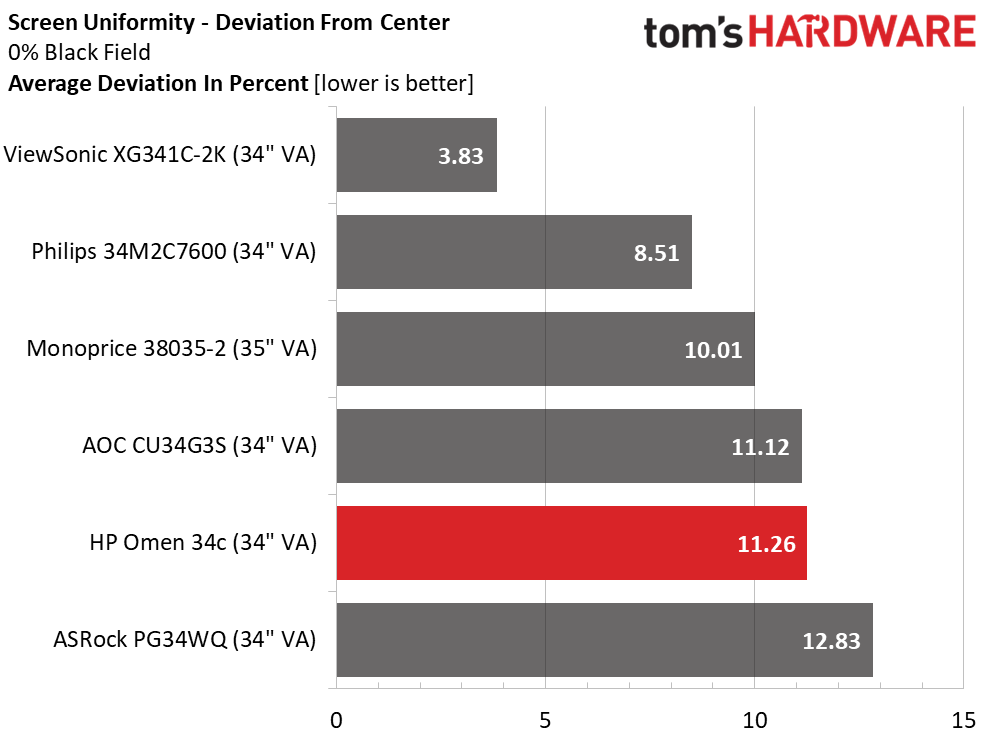Why you can trust Tom's Hardware
The Omen 34c’s comparison charts pit it against other 34-inch ultra-wide VA screens. Two of them are Mini LED, the ViewSonic XG341C-2K and Philips 34M2C7600. Closer in price are the Monoprice 38035-2, AOC CU34G3S and ASRock PG34WQ.
Pixel Response and Input Lag
Click here to read up on our pixel response and input lag testing procedures.


The ViewSonic runs at 200 Hz, so it has a quicker input lag score than the others, but its panel response is no better than the 165 Hz screens. In fact, the Omen 34c is a tick quicker than the average 165 Hz monitor. That gives it visibly better motion resolution. When you engage the overdrive, blur is lowered even further. And its backlight strobe is one of the few that works without significant phasing artifacts. HP has done well with video processing here.
Test Takeaway: There are many 165 Hz QHD screens available, and most perform within a small window. In other words, differences in response and feel are small. The Omen 34c is one of the better examples, with 1ms faster panel response and lower than average input lag. Coupled with excellent overdrive and backlight strobe options, it delivers a better-than-average feel for gamers of all skill levels.
Viewing Angles
Most VA panels perform poorly in this test, but the Omen 34c is better than most. There is a slight red shift at 45 degrees to the side, but light output is only about 30% lower. Gamma stays consistent, so detail is well-rendered when viewing off-axis. The top view is more typical of VA panels with less light, less detail and a blue tint.
Screen Uniformity
To learn how we measure screen uniformity, click here.
My Omen 34c sample was consistent across the screen when showing a black field pattern, but I could see a slight glow in the upper left corner when the room was completely dark. I could not spot this issue in actual content. Color patterns were unblemished. The Omen 34c is slightly below average compared to other VA-based ultra-wide curved monitors.
Get Tom's Hardware's best news and in-depth reviews, straight to your inbox.
MORE: Best Gaming Monitors
MORE: How We Test PC Monitors
MORE: How to Buy a PC Monitor
MORE: How to Choose the Best HDR Monitor
Current page: Response, Input Lag, Viewing Angles and Uniformity
Prev Page Features and Specifications Next Page Brightness and Contrast
Christian Eberle is a Contributing Editor for Tom's Hardware US. He's a veteran reviewer of A/V equipment, specializing in monitors. Christian began his obsession with tech when he built his first PC in 1991, a 286 running DOS 3.0 at a blazing 12MHz. In 2006, he undertook training from the Imaging Science Foundation in video calibration and testing and thus started a passion for precise imaging that persists to this day. He is also a professional musician with a degree from the New England Conservatory as a classical bassoonist which he used to good effect as a performer with the West Point Army Band from 1987 to 2013. He enjoys watching movies and listening to high-end audio in his custom-built home theater and can be seen riding trails near his home on a race-ready ICE VTX recumbent trike. Christian enjoys the endless summer in Florida where he lives with his wife and Chihuahua and plays with orchestras around the state.


